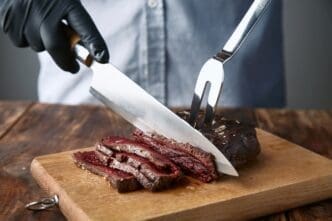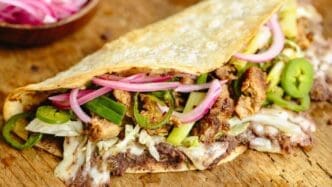In a fascinating culinary exploration, the art of cooking brisket is taken to new levels through an experimental, multi-day cooking process. This endeavor aims to achieve the perfect medium-rare brisket bite, beginning with three different types of brisket: a USDA Choice from the United States, an Australian Wagyu, and the coveted Japanese Wagyu A5.
The first brisket, a USDA Choice from the United States, represents the standard for American backyard barbecue. Priced at approximately $4.50 per pound, it’s characterized by its basic marbling and typical fat content. In contrast, the second contender, an Australian Wagyu brisket, boasts a marbling score of 8 to 9, rendering it nearly four times more expensive than its American counterpart. This cut is renowned for its rich marbling and superior quality.
The most luxurious of the trio is the Japanese Wagyu A5 brisket. Its extravagant marbling is evident at first glance, with fat content that seems to encompass over 50% of the cut. The preparation begins with precision trimming to remove exterior fat, followed by a seasoning of salt and black pepper to enhance flavor and smoke absorption. Smoking over applewood for two hours imparts a desirable bark and initial smoke flavor, though the meat remains far from cooked through.
To achieve the desired tenderness, the brisket undergoes a three-day sous vide process at a consistent temperature, designed to break down collagen while maintaining medium-rare doneness. This method raises questions about whether the Wagyu A5 brisket will reach the tenderness associated with a steak, given its naturally tough structure. As the experiment progresses, attention turns to the remaining cuts.
The USDA Choice brisket undergoes a straightforward trimming and seasoning process before hitting the grill. Its appearance post-smoking showcases a firm bark and a satisfactory smoke ring, a testament to the low and slow cooking method over ten hours. The Australian Wagyu brisket, after a similar preparation, reveals an exceptional level of moisture and tenderness, potentially surpassing the first with its pronounced rich flavor and juiciness.
Finally, the anticipation builds as the three-day wait for the Wagyu A5 brisket concludes. Despite the extended cooking period, the brisket retains its size, indicating minimal shrinkage due to low-temperature cooking. Upon slicing, its interior resembles prime rib more than traditional brisket, with unparalleled tenderness and a pink hue emblematic of its medium-rare state. The subsequent formation of burnt ends coated in homemade barbecue sauce is the last step before tasting.
As the flavors meld, the end result is a rich, buttery bite with a glossy finish from caramelized sugars. The distinct taste of the Wagyu A5 burnt ends showcases the experiment’s success, leaving a lasting impression of sweetness and smokiness. While opinions differ on the preferred brisket, the Australian Wagyu emerges as a favorite for its balance between richness and tenderness.
This foray into brisket cooking not only highlights the diversity in quality and preparation techniques but also underscores the importance of patience and experimentation in achieving culinary excellence. The varying outcomes of the brisket types—each with its own unique flavor profile and texture—offer valuable insights into the art of barbecue. Whether it’s the robust flavor of American brisket or the opulent texture of Wagyu A5, the journey through these cooking methods provides a comprehensive understanding of what makes a perfect brisket.
Source: Youtube








